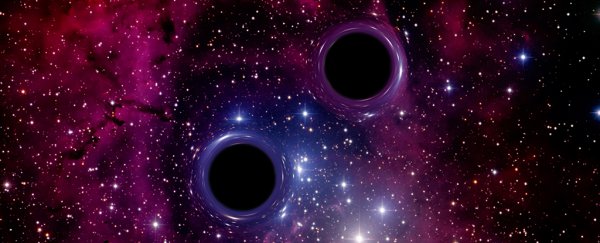Black holes are easily amongst the most enigmatic objects in the Universe, and there's plenty we still don't know about how they're produced and how they evolve.
Now, new research suggests a way of finding black hole 'nurseries' with the right conditions for spawning massive black hole mergers.
Since we first detected gravitational waves in 2015, physicists have been able to use them to detect a flurry of binary black holes (BBH) – systems of two black holes closely orbiting each other before eventually merging in an explosive event.
Thanks to this, astronomers are starting to discern their properties, including a peculiar limitation on mass: most of these black holes locked in a swirling dance appear to reach up to 45 times the mass of our Sun. But not more massive.
There's also a theoretical prediction of an "upper mass gap" limit, suggesting the absence of black holes that have a mass between 50 and 135 solar masses.
One explanation is that as supernovae collapse into black holes, they produce a level of instability that prevents the formation of heavier black hole binaries, hence we're seeing the cut-off in mass.
In the new study, a pair of researchers from the University of Birmingham in the UK and Johns Hopkins University proposes a model of multiple generations of black hole mergers to potentially fill that gap.
"As black holes merge, they form heavier remnants. If these remnants pair with other black holes and generate gravitational waves, they could potentially provide a detectable population of binaries with one or both component masses in the mass gap," the researchers write in their paper.
And the researchers have also provided calculations on just what types of stellar locations might produce such generational black hole mergers.
"Star clusters – groups of stars that are bound together by gravity – might act like black hole nurseries, providing an ideal environment to grow generations of black holes," says astrophysicist Davide Gerosa from the University of Birmingham.
"But in order to know what type of star clusters are most likely to be capable of producing these, we first need to know something about the physical conditions that would be needed."
To do this, the pair calculated the 'escape speed' a star cluster needs to have to be able to host a black hole with a mass above 50 solar masses.
In other words, the cluster needs to be densely packed enough to hang together when binary black hole mergers create a recoil from the resulting gravitational waves. If those conditions are met, black holes up to 130 solar masses might be possible.
That escape speed would need to be greater than 50 kilometres (or 31 miles) per second, the researchers determined – more than most clusters reach. Particularly dense or heavy environments, such as nuclear star clusters, would therefore be required.
"A very massive event would point towards a dense environment with large escape speed," says astrophysicist Emanuele Berti from Johns Hopkins University.
The researchers admit their model is a relatively simple one that's going to need to be refined further – and future measurements from LIGO and the European Virgo detector could help with that.
This latest study suggests that globular clusters – packs of around a million stars near the edge of galaxies – would not have the escape speed required to hold multiple generations of black hole mergers together. Astronomers will have to look elsewhere for their black hole nurseries.
"Gravitational-wave astronomy is revolutionising our understanding of the Universe," says Gerosa. "We are all waiting for upcoming results from LIGO and Virgo to put these and other astrophysical predictions to the test."
The research is due to be published in Physical Review D and can be viewed on the pre-print server arXiv.org.
